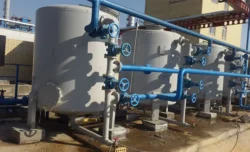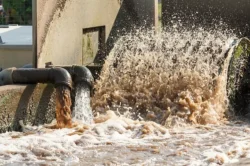
Centrifuge Dewatering Process

The Centrifuge Dewatering Process: An In-Depth Exploration
Dewatering is an essential process in various industries, ranging from wastewater treatment to mining and food processing. Among the various techniques for dewatering, one of the most advanced and effective methods is centrifuge dewatering. This article provides a comprehensive overview of the centrifuge dewatering process, exploring its principles, types, advantages, applications, and challenges.
Table of Contents
-
- Introduction to Dewatering
-
- Principles of Centrifuge Dewatering
-
- Types of Centrifuges Used in Dewatering
-
- The Dewatering Process: Step-by-Step
-
- Advantages of Centrifuge Dewatering
-
- Applications Across Industries
-
- 6.1 Wastewater Treatment
-
- 6.2 Mining
-
- 6.3 Food Industry
-
- 6.4 Chemical and Pharmaceutical Industries
-
- Applications Across Industries
-
- Challenges and Considerations
-
- Environmental and Economic Impacts
-
- Future Trends and Innovations
-
- Conclusion
1. Introduction to Dewatering
Dewatering refers to the process of removing water from solid material or soil by various methods to yield a dry product. This process is crucial in a variety of industries to reduce waste volume, minimize disposal costs, and enhance the efficiency of subsequent processes. Traditional dewatering methods include filtration, sedimentation, and drying, but advancements in technology have led to more efficient methods like centrifuge dewatering.
2. Principles of Centrifuge Dewatering
Centrifuge dewatering is based on the principle of centrifugal force. When a mixture containing solids and liquids is subjected to high-speed rotation, the centrifugal force causes the denser solid particles to move outward against the walls of the centrifuge, while the less dense liquid moves inward. This separation enables efficient dewatering, yielding concentrated solid output and clear liquid discharge.
The effectiveness of centrifuge dewatering depends on several factors, including the speed of rotation, the specific gravity of the solids, the viscosity of the liquid, and the design of the centrifuge.
3. Types of Centrifuges Used in Dewatering
Different types of centrifuges are employed for dewatering purposes, each suited to specific applications. The most common types include:
3.1. Decanter Centrifuge
Decanter centrifuges are widely used for their robust design and high efficiency. They feature a cylindrical bowl and a helical screw conveyor that rotates at different speeds. The solids are forced against the bowl walls, while the screw conveyor moves them toward the discharge end. Decanter centrifuges are ideal for applications requiring continuous operation and handling large volumes of slurry.
3.2. Disk Stack Centrifuge
Disk stack centrifuges are designed with a series of conical disks that enhance the surface area for separation. They are commonly used for separating fine particles and clarifying liquids. These centrifuges are highly effective in industries like pharmaceuticals and biotechnology, where precision and purity are paramount.
3.3. Tubular Bowl Centrifuge
Tubular bowl centrifuges are characterized by their simplicity and high centrifugal force. They are used in applications where fine particle separation and high-speed operation are required. Although they have a lower solids-handling capacity compared to decanter centrifuges, they are suitable for specialized applications like the separation of yeast cells in the brewing industry.
3.4. Basket Centrifuge
Basket centrifuges, also known as perforated basket centrifuges, use a rotating perforated basket to separate solids from liquids. The centrifugal force pushes the solids against the basket walls, while the liquid flows through the perforations. These centrifuges are often used for batch operations in the chemical and pharmaceutical industries.
4. The Dewatering Process: Step-by-Step
The centrifuge dewatering process can be broken down into several key steps:
4.1. Feed Preparation
Before the slurry is introduced into the centrifuge, it undergoes pre-treatment to optimize separation efficiency. This may involve screening to remove oversized particles, chemical conditioning to enhance particle agglomeration, and dilution to achieve the desired solids concentration.
4.2. Feeding
The prepared slurry is fed into the centrifuge at a controlled rate. The feed system ensures a consistent flow of material, preventing any sudden surges that could affect the performance of the centrifuge.
4.3. Separation
Once inside the centrifuge, the high-speed rotation generates centrifugal force, causing the separation of solids and liquids. In a decanter centrifuge, for example, the solids move outward toward the bowl walls, while the liquid forms a concentric inner layer. The screw conveyor transports the solids toward the discharge end, while the clarified liquid is discharged through a separate outlet.
4.4. Discharge
The separated solids and liquids are discharged from the centrifuge through designated outlets. The solids may undergo further processing to achieve the desired dryness, while the liquid can be treated or recycled depending on the application.
4.5. Cleaning and Maintenance
Regular cleaning and maintenance are essential to ensure the optimal performance of the centrifuge. This may involve flushing the system with water or cleaning agents, inspecting the wear and tear of components, and replacing any damaged parts.
5. Advantages of Centrifuge Dewatering
Centrifuge dewatering offers several advantages over traditional dewatering methods:
5.1. High Efficiency
Centrifuges can achieve high separation efficiency, producing a dry solid cake and clear liquid with minimal residual moisture content. This efficiency translates to reduced waste volume and lower disposal costs.
5.2. Continuous Operation
Unlike batch methods, centrifuges can operate continuously, handling large volumes of slurry without interruption. This continuous operation is ideal for industries with high throughput requirements.
5.3. Compact Footprint
Centrifuge dewatering systems occupy less space compared to other dewatering equipment, making them suitable for facilities with limited space.
5.4. Versatility
Centrifuges can handle a wide range of materials and adapt to different applications. Whether dealing with fine particles, coarse solids, or highly viscous liquids, centrifuges offer versatile solutions.
5.5. Reduced Energy Consumption
While centrifuge dewatering requires energy for rotation, advancements in technology have led to energy-efficient designs. Modern centrifuges are designed to minimize energy consumption without compromising performance.
6. Applications Across Industries
The versatility and efficiency of centrifuge dewatering make it indispensable in various industries. Key applications include:
6.1. Wastewater Treatment
In wastewater treatment plants, centrifuge dewatering is used to treat sludge generated during the treatment process. The dewatered sludge has a reduced volume and higher solid content, facilitating easier handling, transportation, and disposal. Centrifuges also help recover valuable resources from sludge, such as biogas through anaerobic digestion.
6.2. Mining
Centrifuge dewatering plays a crucial role in the mining industry by separating water from mineral concentrates and tailings. This process not only reduces the weight and volume of the material for transportation but also enhances the recovery of valuable minerals. Centrifuge dewatering is used in the extraction of precious metals, coal, and various ores.
6.3. Food Industry
In the food industry, centrifuges are used for processes such as the separation of whey from cheese curds, clarification of fruit juices, and extraction of essential oils. The ability to achieve high-quality separation with minimal product loss makes centrifuge dewatering a preferred choice in food processing.
6.4. Chemical and Pharmaceutical Industries
Centrifuge dewatering is employed in the chemical and pharmaceutical industries for the separation of fine chemicals, active pharmaceutical ingredients (APIs), and by-products. The precision and reliability of centrifuges ensure the production of high-purity substances, meeting strict regulatory standards.
7. Challenges and Considerations
While centrifuge dewatering offers numerous benefits, it also presents certain challenges and considerations:
7.1. Initial Investment
Centrifuge dewatering systems require a significant initial investment compared to traditional methods. The cost of procuring and installing high-quality centrifuges can be substantial, which may be a barrier for smaller facilities.
7.2. Maintenance and Operating Costs
Centrifuges demand regular maintenance to ensure optimal performance. The cost of maintenance, including routine inspections, part replacements, and energy consumption, can add to the operating expenses.
7.3. Handling Fine Particles
In applications involving fine particles, the efficiency of centrifuge dewatering may be reduced. Fine particles tend to form stable suspensions, making separation more challenging. Pre-treatment processes, such as flocculation, may be necessary to enhance separation efficiency.
7.4. Noise and Vibration
High-speed rotation in centrifuges generates noise and vibration, which can affect the working environment and nearby equipment. Proper measures, such as soundproofing and vibration-damping systems, must be implemented to mitigate these effects.
7.5. Safety Considerations
Centrifuges operate at high speeds and handle hazardous materials in certain applications. Ensuring safety through proper design, operation protocols, and emergency response plans is critical to prevent accidents and protect personnel.
8. Environmental and Economic Impacts
Centrifuge dewatering has significant environmental and economic impacts:
8.1. Environmental Benefits
By reducing the volume of waste material, centrifuge dewatering contributes to lower disposal costs and reduced environmental impact. The recovered liquid can be treated or recycled, minimizing water consumption and pollution.
8.2. Resource Recovery
In various industries, centrifuge dewatering enables the recovery of valuable resources from waste streams. For example, in wastewater treatment, biogas generated from dewatered sludge can be used for energy production, reducing the reliance on fossil fuels.
8.3. Cost Savings
While the initial investment in centrifuge dewatering systems may be high, the long-term cost savings are substantial. Reduced disposal costs, improved resource recovery, and enhanced process efficiency contribute to overall economic benefits.
9. Future Trends and Innovations
The field of centrifuge dewatering continues to evolve with advancements in technology and research. Future trends and innovations include:
9.1. Enhanced Energy Efficiency
Researchers and manufacturers are focusing on developing more energy-efficient centrifuge designs. Innovations such as variable speed drives, optimized bowl geometries, and advanced control systems aim to reduce energy consumption without compromising performance.
9.2. Automation and Digitalization
Automation and digitalization are revolutionizing the dewatering process. Smart sensors, real-time monitoring, and predictive maintenance algorithms enable operators to optimize performance, detect faults early, and reduce downtime.
9.3. Sustainable Materials
The development of sustainable materials for centrifuge components is gaining attention. Materials with improved wear resistance, reduced environmental impact, and longer service life enhance the overall sustainability of centrifuge dewatering systems.
9.4. Advanced Pre-Treatment Techniques
Advancements in pre-treatment techniques, such as microwave-assisted conditioning and electrocoagulation, are being explored to improve the efficiency of centrifuge dewatering. These techniques enhance particle agglomeration, making separation more effective.
10. Conclusion
Centrifuge dewatering is a sophisticated and efficient method for separating solids from liquids in various industries. With its high efficiency, continuous operation, and versatility, centrifuge dewatering offers significant advantages over traditional methods. The process involves feed preparation, feeding, separation, discharge, and maintenance, ensuring optimal performance and reliability.
Applications of centrifuge dewatering span across wastewater treatment, mining, food processing, and chemical industries, showcasing its versatility and importance. However, challenges such as initial investment, maintenance costs, and handling fine particles must be addressed to maximize its benefits.
The environmental and economic impacts of centrifuge dewatering are substantial, contributing to waste reduction, resource recovery, and cost savings. As technology advances, future trends and innovations promise to enhance energy efficiency, automation, sustainability, and pre-treatment techniques, further advancing the field of centrifuge dewatering.
In conclusion, centrifuge dewatering stands as a pivotal process in modern industrial operations, driving efficiency, sustainability, and economic benefits. As industries continue to innovate and adopt advanced technologies, centrifuge dewatering will remain at the forefront of dewatering solutions, shaping the future of waste management and resource recovery.

